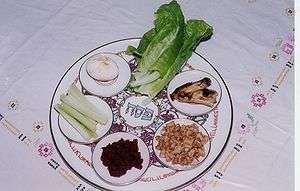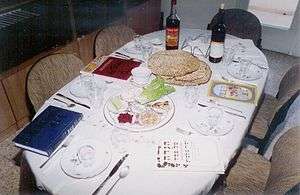Passover Seder plate

The Passover Seder plate Hebrew: ke'ara (קערה) is a special plate containing symbolic foods eaten or displayed at the Passover Seder.
Significance
Each of the six items arranged on the plate has special significance to the retelling of the story of Passover — the exodus from Egypt — which is the focus of this ritual meal. A seventh symbolic item used during the meal — the three matzos — is not considered part of the seder plate proper.
Symbolic foods
The six traditional items on the Seder Plate are as follows:
- Maror and Chazeret — Bitter herbs symbolizing the bitterness and harshness of the slavery the Hebrews endured in Egypt. In Ashkenazi tradition, fresh romaine lettuce or endives (both representing the bitterness of the Roman invasions) or horseradish may be eaten as Maror in the fulfillment of the mitzvah of eating bitter herbs during the Seder. Chazeret is additional bitter herbs, usually romaine lettuce, used in the korech sandwich.
- Charoset — A sweet, brown mixture representing the mortar and brick used by the Hebrew slaves to build the storehouses or pyramids of Egypt. In Ashkenazi Jewish homes, Charoset is traditionally made from chopped nuts, grated apples, cinnamon, and sweet red wine

- Karpas — A vegetable other than bitter herbs representing hope and renewal, which is dipped into salt water at the beginning of the Seder. Parsley or another green vegetable.[1] Some substitute parsley to slice of green onion (representing the bitterness of slavery in Egypt) or potato (representing the bitterness of the ghetto in Germany and in other European countries), both commonly used. The dipping of a simple vegetable into salt water, and the resulting dripping of water off of said vegetables visually represents tears and is a symbolic reminder of the pain felt by the Hebrew slaves in Egypt. Usually in a Shabbat or holiday meal, the first thing to be eaten after the kiddush over wine is bread. At the Seder table, however, the first thing to be eaten after the kiddush is a vegetable. This leads immediately to the recital of the famous question, Ma Nishtana — "Why is this night different from all other nights?" It also symbolizes the spring time, because Jews celebrate Passover in the spring.
- Zeroah — Also transliterated Z'roa, it is special as it is the only element of meat on the Seder Plate. Roasted chicken neck or shankbone; symbolizing the Paschal Lamb (Passover sacrifice), which was a lamb that was offered in the Temple in Jerusalem, then roasted and eaten as part of the meal on Seder night. Since the destruction of the Temple, the z'roa serves as a visual reminder of the Pesach sacrifice; it is not eaten or handled during the Seder. Vegetarians often substitute a beet, quoting Pesachim 114b as justification; other vegetarians substitute a sweet potato, allowing a "Paschal yam" to represent the Paschal lamb.
- Beitzah — A roasted hard-boiled egg, symbolizing the korban chagigah (festival sacrifice) that was offered in the Temple in Jerusalem and roasted and eaten as part of the meal on Seder night. Although both the Pesach sacrifice and the chagigah were meat offerings, the chagigah is commemorated by an egg, a symbol of mourning (as eggs are the first thing served to mourners after a funeral), evoking the idea of mourning over the destruction of the Temple and our inability to offer any kind of sacrifices in honor of the Pesach holiday. Since the destruction of the Temple, the beitzah serves as a visual reminder of the chagigah; it is not used during the formal part of the seder, but some people eat a regular hard-boiled egg dipped in saltwater as the first course of the meal.

Many decorative and artistic Seder plates sold in Judaica stores have pre-formed spaces for inserting the various symbolic foods.

The sixth symbolic item on the Seder table is a plate of three whole matzot, which are stacked and separated from each other by cloths or napkins. The middle matzah will be broken and half of it put aside for the afikoman. The top and other half of the middle matzot will be used for the hamotzi (blessing over bread), and the bottom matzah will be used for the korech (Hillel sandwich).
A bowl of salt water, which is used for the first "dipping" of the Seder, is not traditionally part of the Seder Plate, but is placed on the table beside it. However, it sometimes is used as one of the six items, omitting chazeret.
Variants
- Orange — Some Jews include an orange on the Seder plate.[2] The orange represents the fruitfulness for all Jews when marginalized Jews, particularly women and gay people, are allowed to become active and contribute to the Jewish community.[2] A common, though incorrect, rumor says that the tradition began when a man told Susannah Heschel that a woman has as much business on the bimah in a synagogue as an orange does on the Seder plate.[2] In fact, the tradition began when Heschel spoke at Hillel at Oberlin College, where she saw an early feminist haggadah that recommended adding a crust of bread to the Seder plate as a sign of solidarity with lesbian Jews.[2][3] Heschel felt putting bread on the Seder plate would mean accepting the idea that lesbian and gay Jews are as incompatible with Judaism as chametz is with Passover.[2] At her next Seder, she used an orange as a symbol of inclusion for lesbians, gays, and others who are marginalized by the Jewish community.[2][3]
- Olive — In 2008, Jewish Voice for Peace proposed adding an olive to the seder plate to symbolise olive trees that have been uprooted in Palestine[4] and this has now become a regular addition for some Jews.[5]
Over the years, Pesach has often been used as an occasion for political or social commentary. This was often the case when the departure of Soviet Jews was compared to the departure of the Jews from Egypt.
See also
- Jewish ceremonial art
- Haft-Seen, a similar display for Nowruz, the Iranian new year, may have influenced the development of the Seder plate
References
- ↑ A Passover Haggadah: As Commented Upon by Elie Wiesel and Illustrated by Mark Podwal (Simon & Schuster, 1993, ISBN 0671799967)
- 1 2 3 4 5 6 Cohen, Tamara. "An Orange on the Seder Plate". My Jewish Learning. Retrieved 15 June 2016.
- 1 2 Eisehnbach-Budner, Deborah; Borns-Weil, Alex. "The Background to the Background of the Orange on the Seder Plate and a Ritual of Inclusion". Ritualwell. Retrieved 15 June 2016.
- ↑ "Non-traditional items showing up on Seder plates". The Jerusalem Post. Jewish Telegraphic Agency. 5 April 2011. Retrieved 3 April 2015.
- ↑ Fishkoff, Sue (April 12, 2011). "From oranges to artichokes, chocolate and olives, using seder plate as a call to action". Jewish Telegraphic Agency.